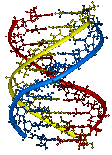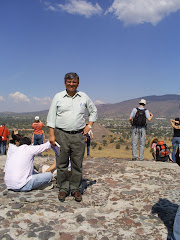
Estimados:
Un excelente cientifico peruano y tambien amigo personal me acaba de recordar este artículo publicado en la revista Nature hace ya algunos años. Se trata de un comentario sobre el libro Enriching the Earth: Fritz Haber, Carl Bosch, and the Transformation of World Food de Vaclav Smil. De todo el comentario el parrafo que mas me impacto es el que comienza el analisis del libro:
" The greatest catastrophe that the human race could face this century is not global warming but a global conversion to 'organic' farming — an estimated 2 billion people would perish. That is the underlying message of this remarkable book, which charts the discovery of nitrogen fixation — the conversion of unusable atmospheric nitrogen to useful ammonia — and its impact on the world's food supply...."
Quizás alguien en el entorno del nuevo Ministro de Agricultura sea lo suficientemente generoso como para conseguirlo y leérselo. El Perú no puede seguir el camino al que tercamente nos quiere llevar el fundamentalismo orgánico.
Quizás alguien en el entorno del nuevo Ministro de Agricultura sea lo suficientemente generoso como para conseguirlo y leérselo. El Perú no puede seguir el camino al que tercamente nos quiere llevar el fundamentalismo orgánico.
La pregunta clave es: ¿Queremos alimentar a 40 personas o solo a 10 personas por cada hectárea? o en las palabras del comentarista:
"... Humans have a stark choice to make: do we farm four hectares of land 'organically' to feed 40 souls, or do we farm one hectare 'artificially', thereby leaving the other three to natural woodland and wildlife?
"... Humans have a stark choice to make: do we farm four hectares of land 'organically' to feed 40 souls, or do we farm one hectare 'artificially', thereby leaving the other three to natural woodland and wildlife?
Es obvio que el Perú no va aumentar de tamaño pero si de población (40 millones para el 2050) y por ello lo más sustentable sería NO aumentar la tierra arable a costa de la destrucción de la biodiversidad sino mediante la tecnología. La mejor alternativa para aumentar la productividad de nuestros cultivos es usar toda la tecnologia que la ciencia moderna nos puede ofrecer, incluyendo el uso de los OGMs donde estos sean competitivos y proporcionen soluciones únicas y necesarias.
Saludos
Luis Destefano Beltrán, Ph.D.
Book Review Nature 410, 633-634 (5 April 2001)
Going one better than nature?
John Emsley
BOOK REVIEWED- Enriching the Earth: Fritz Haber, Carl Bosch, and the Transformation of World Food by Vaclav Smil, MIT Press: 2001. 339 pp. $34.95, £23.95
The greatest catastrophe that the human race could face this century is not global warming but a global conversion to 'organic' farming — an estimated 2 billion people would perish. That is the underlying message of this remarkable book, which charts the discovery of nitrogen fixation — the conversion of unusable atmospheric nitrogen to useful ammonia — and its impact on the world's food supply.If crops are rotated and the soil is fertilized with compost, animal manure and sewage, thereby returning as much fixed nitrogen as possible to the soil, it is just possible for a hectare of land to feed 10 people — provided they accept a mainly vegetarian diet. Although such farming is almost sustainable, it falls far short of the productivity of land that is fertilized with 'artificial' nitrogen; this can easily support 40 people, and on a varied diet. Of course, 'organic' farming should be encouraged in order to recycle compost and dung. But it can never compete with the bountiful supply of agrochemical nitrogen, which now meets about 40% of the world's dietary needs. Nitrogen is abundant in the atmosphere, but in a form that is difficult to extract; only a few microbes and plants have the capacity to do this. Yet, thanks to their efforts over aeons of time, a whole planetary ecology can now be sustained. This organic nitrogen will even support continued agriculture if properly managed, but it imposes a maximum on the density of the human population.
The greatest catastrophe that the human race could face this century is not global warming but a global conversion to 'organic' farming — an estimated 2 billion people would perish. That is the underlying message of this remarkable book, which charts the discovery of nitrogen fixation — the conversion of unusable atmospheric nitrogen to useful ammonia — and its impact on the world's food supply.If crops are rotated and the soil is fertilized with compost, animal manure and sewage, thereby returning as much fixed nitrogen as possible to the soil, it is just possible for a hectare of land to feed 10 people — provided they accept a mainly vegetarian diet. Although such farming is almost sustainable, it falls far short of the productivity of land that is fertilized with 'artificial' nitrogen; this can easily support 40 people, and on a varied diet. Of course, 'organic' farming should be encouraged in order to recycle compost and dung. But it can never compete with the bountiful supply of agrochemical nitrogen, which now meets about 40% of the world's dietary needs. Nitrogen is abundant in the atmosphere, but in a form that is difficult to extract; only a few microbes and plants have the capacity to do this. Yet, thanks to their efforts over aeons of time, a whole planetary ecology can now be sustained. This organic nitrogen will even support continued agriculture if properly managed, but it imposes a maximum on the density of the human population.
All this changed on 3 July 1909, when two German chemists, Fritz Haber and Carl Bosch, proved that it was possible to convert atmospheric nitrogen into ammonia on an industrial scale. Today there are Haber–Bosch chemical plants around the world, producing 150 million tonnes of ammonia a year, most of which goes into making fertilizer. The nitrogen input into farmed land from these fertilizers now exceeds the natural input. Even low-income countries can afford Haber–Bosch factories, and these should begin to turn around food production there, just as they did in high-income economies.In the final chapter of Enriching the Earth, Vaclav Smil of the University of Manitoba admits that he originally intended to write a biography of Haber and Bosch, but he quickly realized that an account of the effects of their research would be far more interesting, and concentrated on this. He was right to do so.Smil begins by looking at the fact that all living things need nitrogen in order to make amino acids, the building-blocks for the proteins on which life depends. He explains how nitrogen is fixed naturally, and how traditional farming takes this from the soil, but with only partial success at returning waste material to fertilize future crops. The first successful nitrogen fertilizers came from the Chilean guano deposits in the nineteenth century, a clearly limited supply.
The central theme of Enriching the Earth tells of Haber's struggle to make hydrogen gas (H2) react directly with nitrogen gas (N2) to form ammonia (NH3), and of Bosch's faith that the process could be made to work commercially. Bosch then convinced the German chemical company BASF to invest in it. Thus was an industry born. But it was not immediately seen as the answer to the world's food supply; instead, it fed into Germany's need for ammunition to fight two world wars. Ammonia from the Haber–Bosch factories was converted to nitric acid and thence to explosives. After 1945, however, the overwhelming use of such factories was to fix nitrogen for fertilizers.Smil recounts how the industry developed, and how much of the world's population is now supported by it. He discusses how this chemical bounty is disbursed. Relatively little is used by US agriculture, but a great deal by Chinese farmers. Smil considers what will happen when developing economies also want their protein to be in the easily digested and tasty kind that comes from meat, even though this is the least efficient way of producing food. But can our planet support another 5 billion people on a Western diet, and won't more food simply encourage more humans to have yet more children? Smil's answer is found in his chapter "Nitrogen and civilization".
The future looks surprisingly reassuring. The annual increase in global population will continue to decline even though food production is rising, and the total might well peak at less than 9 billion by the year 2050, declining thereafter.This is a wonderful book, highly readable and replete with referenced data. It is soundly based on the chemistry that underpins our food supply, or at least the protein part of it, and is an ideal corrective to the misleading ideas we are constantly being fed by the organic food movement. Humans have a stark choice to make: do we farm four hectares of land 'organically' to feed 40 souls, or do we farm one hectare 'artificially', thereby leaving the other three to natural woodland and wildlife? There is a place for 'organic' farming, but only insofar as it permits us to recycle nitrogen that would otherwise go to waste.
John Emsley is in the Department of Chemistry, University of Cambridge, Lensfield Road, Cambridge CB2 1EW, UK.













No hay comentarios:
Publicar un comentario